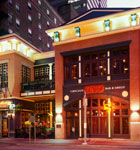At a Glance
Location
Dallas
Founded
1993
Employees
38
Specialties
Global sourcing, purchasing, and installation of furnishings, operating equipment, systems, and construction materials for the hospitality industry
Annual Purchasing
$250 million
What drives sustainability in the hospitality sector?
Bill Langmade: The architects, interior designers, and builders came first. For FF&E, initially it was [about] the “feel good” [element], but as designers started demanding sustainable products, vendors responded to their demands in order to compete. In the hospitality industry much of the LEED-green push is on the operations and building side, not the FF&E purchase.
Sounds like there has been a lag in how FF&E is factored into sustainability. Why is that?
BL: There are some points for FF&E within LEED-accreditation standards, but about 90 percent of products in this category are replaced in three to five years. It’s not an easy category in which to be green.
OK, so what are the small victories, if you will, of FF&E becoming more Earth-friendly?
BL: One by one, manufacturers are coming up with their own green products and manufacturing methods. The carpeting industry is doing it best and biggest. The product lasts between 5 and 10 years, but now sales contracts are written such that the vendor is also responsible for recycling the product at the end of its use cycle. Old carpets that used to end up in a landfill are now recycled as raw material in new carpets—for auto interiors and even casket linings.

What about the other industries—such as those that aren’t yet able to supply green products?
BL: A lot of FF&E is manufactured in Asia, so it’s hard to be green when there is that much transportation involved. But many products we buy are short-run specialty items, and some manufacturers are coming back to the US—to better control quality, to reduce shipping costs, and to allow shorter lead times. And they are working on such things as recycled materials in furniture fabrics and organically grown cotton in linens.
In a project for a Dallas hotel, we were getting bids from vendors in China and Oklahoma. Factoring in freight costs—which domestically can be around six percent of product costs—the Oklahoma supplier was faster, less expensive overall, and we were able to manage the process better. There also was less cardboard carton waste.

When you sat for the LEED AP exam, you were the only purchasing agent to do so. Do you know of anyone else in your business who is doing this?
BL: Yes, I’ve heard of a few other purchasing people who are getting accredited. But almost everyone is working on recycling. For me, getting accredited as a LEED AP provided a frame of reference. It’s also a way for our company to come out in front in that area.
From the customer side, what factors are driving an eco-consciousness?
BL: The boutique hotels are certainly a big driver. But across the board the hospitality industry is striving for cleaner environments. Research [from the USGBC] shows that both employees and guests at hotels feel better and are more productive when there is no toxic off-gassing from furniture and carpeting.

You work between the vendors and building owners and architects. Who is educating whom about green elements and practices when you work on a project?
BL: When we are working on a LEED project, we help designers buy in a smart way. With vendors, we educate them on how they can be green from a competitive standpoint.
You write about how your own father called you a tree hugger many years ago. Does the fact that this has become a business advantage vindicate you today?
BL: [Laughs] My father was a bit of a tree hugger himself. The industry has gotten very interesting now, and there absolutely is a spirit of innovation out there. Not only are suppliers competing on color, style, and price, but sustainability is part of the conversation. It’s amazing what the building industry has done in terms of becoming more energy-efficient and providing healthier environments. ABQ


